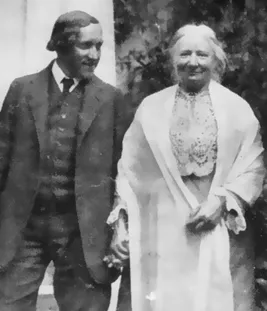Psychology is concerned with human beings’ (and animals’) understanding of the physical and social environment, and the bases for their actions, feelings and experiences, as well as their participation in greater and smaller social networks and in society. Developmental psychology is concerned with how all this comes about, how children gradually change socially, mentally and behaviorally, the underlying processes, and the factors that may influence these changes, for example how children’s understanding of the world and thinking changes over time, what makes children develop different abilities, how children form relationships with parents and peers, why boys and girls tend to play in different ways and come to have different interests and behavior, why some children are socially active and extrovert while others are more shy and careful, and how emotional expressivity differs between cultures. Developmental psychology also includes the developmental courses of children with sensory and physical disabilities, as well as the vulnerability and risk factors that underlie the emergence of learning disorders and emotional and behavioral disorders in childhood and adolescence, and factors that may prevent the development of such disorders.
Development can be defined as an age-related process involving changes in the structure and functioning of human beings and animals as a result of interaction between biological structures, psychological states and ecological factors. While the organism adapts to its environment, the environment must also have properties that allow the organism to develop. At the core of the developmental process lies transformation: something new emerges, less becomes more, simplicity turns into complexity, limited skills evolve into advanced mastery (Overton, 2015). In all species, development toward adulthood implies a greater degree of autonomy and independence from the parent, and in human beings and many other species also increasing social affiliation (Keller, 2016). The main characteristic of development is change, but in most areas there is both change and continuity. The individual develops new ways of understanding and mastering the world, but always building on past experiences and remaining the same individual (Nelson, 2007a).
Development involves characteristics and abilities that are common to all human beings. Some are shared by humans and many other species, such as the ability to see, hear and walk, while others, such as talking and reflecting on the past and future, distinguish human beings. In addition, development entails processes that contribute to individual differences in particular traits and abilities. Some changes are quantifiable, such as children’s physical growth or the number of words they say. Changes in areas such as reasoning ability, social adaptation and moral formation are not quite as easy to quantify. They represent qualitative differences. The particular objective of developmental theories is to explain the emergence of new abilities and qualitative changes, both common and individual differences, and change as well as continuity (Kagan, 2008a; Spencer and Perone, 2008; see Chapter 2).
With age, children engage in a growing number of activities and social relationships. They acquire the knowledge and values of their society, and adapt to the physical and social cultural landscape, a process known as enculturation. Some children grow up in a conglomerate of different cultures and their development reflects the multi-cultural background (Bronfenbrenner, 1979; Josephs and Valsiner, 2007).
THE HISTORICAL ROOTS OF DEVELOPMENTAL PSYCHOLOGY
Psychology is a relatively young scientific discipline. Its origins are often dated to 1879, the year in which Wilhelm Wundt opened the first psychological laboratory in Leipzig. This marked the transition from largely informal observations to a more systematic methodology in the study of human perception, thinking, feeling and action. Nonetheless, most key issues in psychology are deeply rooted in philosophy and medicine, and many of its main topics can be traced back to ancient reflections on human nature. Until the late nineteenth century, child development was primarily an educational field, and literature on children mostly dealt with upbringing and education (e.g., Herbart, 1841; Rousseau, 1763). A few researchers, like Tiedemann (1787) and Darwin (1877), described their children’s development in detail, while Preyer published the first textbook with a general perspective on development in 1882. In 1900, Ellen Key proclaimed the twentieth century as The Century of the Child. It was equally to be the century of developmental psychology.
Developmental psychology encompasses widely different traditions that have moved toward and away from each other throughout history and influenced one another in varying degrees (see Chapter 2). The theories reflect the knowledge that was acquired, but also the spirit of the age and the overall development of the society. Many attempts have been made to unite different perspectives, but there is still disagreement about basic developmental issues, such as the organization and biological bases of cognition (see Chapter 9). Attempts at syntheses that integrate views from several directions and take into account the critique of others persist into the twenty-first century. Present day “developmental science” crosses disciplinary boundaries and integrates perspectives from developmental psychology with anthropology, sociology, linguistics, medicine and technology (Witherington, 2014; Zelazo, 2013).
GLOBALIZATION
Globalization has become an integral part of modern societal development, and has also impacted the development of scientific thinking (Valsiner, 2012). Early in the history of developmental psychology, Western European psychology was dominant, and after World War II, American psychology assumed a leading role (Jensen, 2012). At the same time, theories were developed in other countries, which did not always receive international attention. Vygotsky’s influential book Thought and language, for example, was first translated into English in 1962, 28 years after the author’s death. Today the debate on development continues in Russia, but only a minor part of publications are translated into English (see Karpov, 2005; Vassilieva, 2010).
Cross-cultural studies are important for understanding the relationship between nature and nurture in development (see Bornstein, 2010; Nielsen and Haun, 2016). Similarly, crosscultural discussions of scientific ideas are crucial to the advancement of developmental theories. For example, one-third of the world’s children live in India and China, but since neither country engages in much systematic theoretical work, India and China have little influence on international research in developmental psychology. In China, this is partly due to the fact that psychology as a field, and individual-oriented psychology in particular, has essentially been an alien concept to the Chinese, since the group, rather than the individual, represent the natural unit in Chinese culture (Tardif and Miao, 2000). Moreover, during the Cultural Revolution (1966–1976), many psychology departments at universities were shut down (Blowers et al., 2009; Bond, 2010; Miao and Wang, 2003). In India, the British colonial powers had a considerable impact. Many of the studies involved children from upper middle class urban families and generalization to other social classes is uncertain (Saraswathi and Dutta, 2010). Today, both countries are establishing traditions with a stronger basis in their own values and cultures. Also in Africa, psychology has been an article of import, but the number of studies founded on African ecologies and perceptions of reality is steadily growing. Here, too, an important discussion concerns the relationship between a universal and a local cultural understanding of developmental processes (Marfo, 2011; Nsamenang and Lo-Oh, 2010).
While globalization and English as the lingua franca of academia contribute to more equality in the development of theories across national borders, they also highlight the differences between countries and contribute to the establishment of unique cultural scientific identities. In the age of globalization, developmental perspectives with an origin in African, Asian and other cultures will emerge and find their position in international developmental psychology, both locally and globally. The coming years will show how these perspectives position themselves.
TYPICAL AND ATYPICAL DEVELOPMENT
Some children acquire certain skills and abilities early on, while others have a late or unusual development in one or more areas. A smaller group of children have disabilities or disorders that inhibit all or some aspects of development, and have to perform many actions in unconventional ways. The most common course is typical development, with unimpaired functions and ordinary individual differences between children. Atypical development is a broad term used to describe all forms of irregular development, such as deaf children with a normal but unusual language development when they learn sign language instead of spoken language (Marschark et al., 2006), or children with intellectual disability who think and reason differently from their peers (Carr et al., 2016). Atypicality thus does not have to imply abnormality, only that something is done in less common ways. Knowledge of atypical development contributes to insight into developmental processes in general and there is a long tradition of comparing the developmental trajectories of children with different prerequisites. Many early researchers included children with visual impairment, hearing impairment and intellectual disability in their discussions of child development (e.g., Luria, 1961; Piaget, 1970).
Every age level sees the emergence of abilities and skills that are particularly prominent or important for that age and form the basis for further development. Early skills and characteristics involve among others the ability to grasp objects, followed a little later by independent mobility and attachment to a primary caregiver, and then to the development of language, understanding of minds, and morality. There are several ways of acquiring such skills and traits, both typical and atypical developmental paths. Children with severe mobility impairments may need a wheel chair to explore their surroundings, but their exploration has the same function and importance as for children without such impairments (Anderson et al., 2013; Campos et al., 2000). Blind children usually show normal language development, even though they have to learn words with some other cues than sighted children (Pérez-Pereira and Conti-Ramsden, 1999).
It is the same basic principles that underlie all forms of development, regardless of whether it proceeds in an ordinary or unusual manner. Knowledge of typical development is necessary to understand atypical development, and know ledge of atypical development – of what can go wrong and how to compensate for impaired skills and abilities – is necessary to understand the developmental process in general (Cicchetti, 2013; Dekker and Karmiloff-Smith, 2011). The study of “theory of mind” in children with autism spectrum disorder and other disorders (see Chapter 13), for example, has been important in gaining insight into how children develop relationships and an understanding of how other people think and feel (Hughes and Leekam, 2004; Leekam, 2016). Most children with typical development will show positive development in quite different environments. Children with atypical development have a narrower range of possibilities and depend on an environment that fits their possibilities.
SOME RECURRENT ISSUES IN DEVELOPMENTAL PSYCHOLOGY
Many of the same issues appear in relation to descriptions and explanations of different developmental aspects.
Genes, environment and culture
The lay belief in genetic inheritance is strong and parents typically point to similarities between their children and various family members. The role of heredity and environment in the development of individual differences is also one of the most discussed themes in developmental psychology (see Chapter 5). Another issue is the universality of abilities and traits. Some characteristics and abilities seem to evolve in regular patterns across cultures, while others differ from one culture to the next. For example, children of all cultures learn to speak, but they speak different languages. Comparison of how children develop in different cultures is an important tool for understanding the biological and cultural bases of abilities and characteristics, including cultural differences in demographics,...


